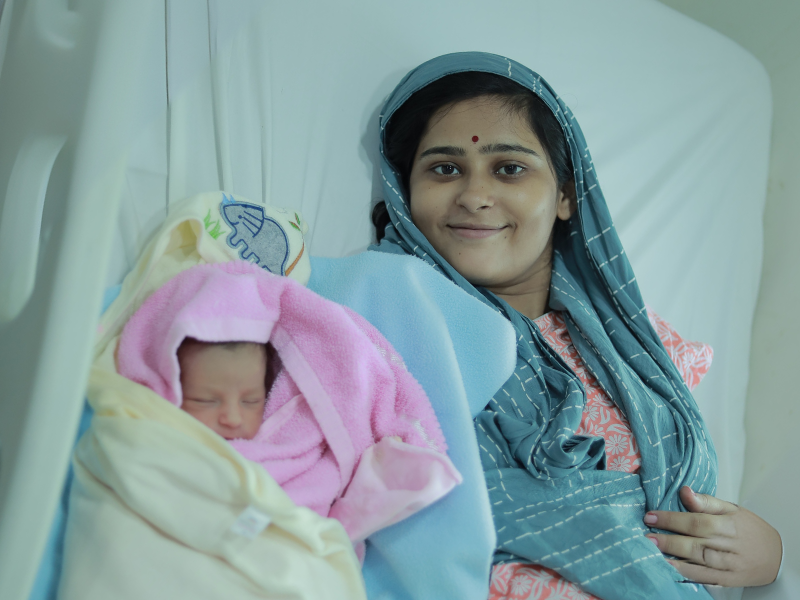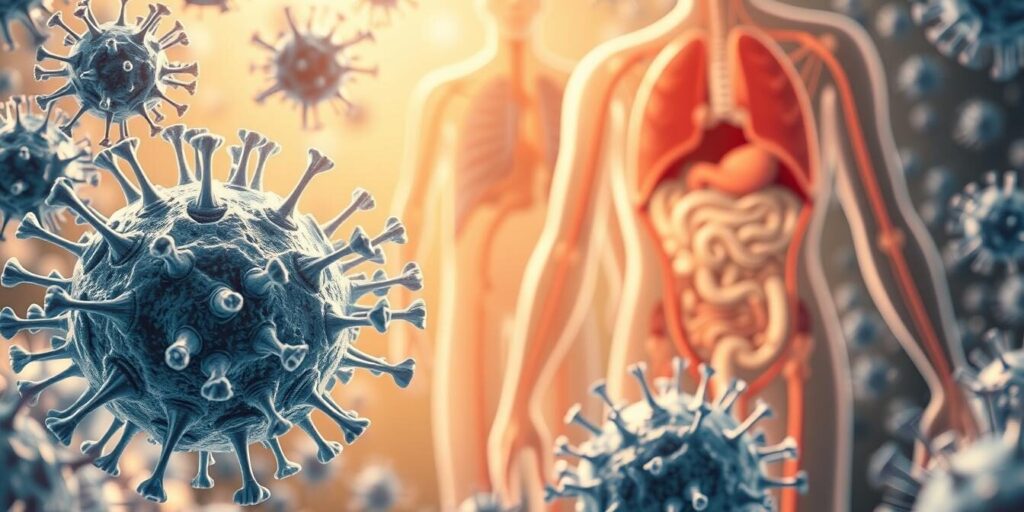Bacteria are tiny, single-celled organisms that can make people sick. Kids often get skin infections like impetigo, ear infections, and throat infections such as strep. Some serious infections, like bacterial meningitis and pneumonia, can be stopped with early vaccines.
Some kids are more at risk, like babies under 3 months or those with weakened immune systems. Knowing how to prevent these infections is key to keeping kids healthy.
Key Takeaways
- Bacteria can cause a variety of common infections in children, including skin, ear, and throat infections.
- Severe bacterial infections, such as meningitis, pneumonia, and UTIs, can be prevented through timely immunisation.
- Certain children, including infants and those with weakened immune systems, are at higher risk of developing bacterial infections.
- Proper hand hygiene, environmental cleanliness, and vaccination are crucial for preventing the spread of bacterial infections in children.
- Recognising the symptoms of bacterial infections and seeking prompt medical attention can help ensure effective treatment and recovery.
Understanding Bacterial Infections in Children
Bacterial infections are common in kids. They can affect the skin, ears, and throat. Knowing about bacterial infections helps prevent and treat them.
What are Bacterial Infections?
Bacterial infections happen when harmful bacteria grow. They can come from the environment, other people, animals, or contaminated food and water. Most bacteria are harmless, but they can cause problems if they grow where they shouldn’t.
Common Causes of Bacterial Infections in Children
Bacterial infections in kids often come from a few main sources:
- Foodborne and Waterborne Transmission: Eating or drinking contaminated food or water can lead to illnesses like food poisoning. This is caused by bacteria like Campylobacter and Salmonella.
- Vector-Borne Transmission: Tick-borne infections, such as Lyme disease, are caused by bacteria.
- Contact Transmission: Bacteria can spread through touch, causing infections like Chlamydia and gonorrhea.
- Airborne and Droplet Transmission: Respiratory infections, like strep throat, spread through the air.
Knowing how bacteria spread helps prevent bacterial infections in kids.
| Bacterial Infection | Transmission Method | Common Symptoms |
|---|---|---|
| Foodborne Illnesses (e.g. Salmonella, Campylobacter) | Contaminated food or water | Diarrhoea, vomiting, abdominal pain |
| Lyme Disease | Tick-borne | Rash, fever, joint/muscle pain |
| Sexually Transmitted Infections (e.g. Chlamydia, Gonorrhea) | Direct/indirect contact | Abnormal discharge, pain, fever |
| Strep Throat | Airborne/droplet transmission | Sore throat, fever, swollen lymph nodes |
Knowing the causes of bacterial infections in kids is the first step to preventing and treating them.
Common Bacterial Infections in Children
Young children often get bacterial infections. These can affect their skin, ears, or throats. Common ones include impetigo, cellulitis, otitis media, and streptococcal pharyngitis.
Skin Infections: Impetigo and Cellulitis
Impetigo is a contagious skin infection common in kids. It’s caused by bacteria and shows up as red sores or blisters. Cellulitis is a deeper infection that causes redness, swelling, and pain.
Ear Infections: Otitis Media
Otitis media, or ear infections, are common in children. They cause pain, fever, and hearing problems. Untreated, they can lead to hearing loss or spread to other parts of the body.
Throat Infections: Streptococcal Pharyngitis
Streptococcal pharyngitis, or strep throat, is a bacterial infection of the throat and tonsils. It’s caused by Group A Streptococcus and can cause a sore throat, fever, and swollen lymph nodes. If not treated, it can cause serious problems like rheumatic fever or kidney inflammation.
These infections are treated the same in kids and adults. But, they can be serious if not managed well. Parents should watch for symptoms and get medical help if needed.
High-Risk Groups for Bacterial Infections
Bacterial infections can hit children of all ages, but some are at higher risk. Infants under 3 months and children with weak immune systems are especially vulnerable.
Infants Under 3 Months Old
Newborns have a developing immune system, making them more susceptible to infections. In 2015, young children faced a big disease burden from respiratory infections. These can lead to serious health issues, including hospital stays.
Children with Compromised Immune Systems
Children with weakened immune systems face a higher risk of serious infections. Before treatments like combination antiretroviral therapy, bacterial infections were common in HIV kids. Now, while rates have dropped, these children still face dangers from certain bacteria.
| Risk Group | Increased Risk of Bacterial Infections |
|---|---|
| Infants under 3 months | Immature immune system, higher risk of respiratory syncytial virus infections |
| Children with compromised immune systems | Higher risk of pneumonia, bacteremia/sepsis, pneumococcal, Haemophilus influenzae, and meningococcal infections |
It’s vital for healthcare teams and parents to watch for signs of infection in these high-risk groups. Quick action is key when spotting symptoms.
Transmission of Bacterial Infections in Children
Bacterial infections can spread in many ways, affecting children’s health. It’s important to know how they spread. This helps us take steps to prevent them and get medical help quickly.
Airborne and Droplet Transmission
Some infections, like Legionnaires’ disease and tuberculosis, spread through the air. When someone coughs or sneezes, tiny droplets with bacteria can be breathed in by others. This can happen even if you don’t touch the infected person.
Contact Transmission
Infections like impetigo and sexually transmitted diseases spread through touch. They can also spread through sharing things or having sex with someone who’s infected.
Vector-Borne Transmission
Infections like Lyme disease spread through ticks and mosquitoes. These bugs pick up and spread the bacteria. This is more common in areas where these bugs are found.
Foodborne and Waterborne Transmission
Infections from E. coli and Salmonella come from bad food or water. Poor food handling or using dirty water can spread these infections.
Knowing how bacterial infections spread helps us protect children. We can prevent them and get help fast to keep kids safe.
Preventing Repeated Bacterial Infections in Children
Keeping children healthy is very important. It’s key to stop them from getting the same bacterial infections over and over. Parents and caregivers can help a lot by making sure hands are clean and the environment is tidy.
Hand Hygiene and Environmental Cleanliness
Washing hands properly is a top way to stop bacterial infections from spreading. Teach kids to wash their hands well with soap and water, especially before eating and after using the bathroom. Also, keep surfaces clean and disinfected often to stop bacteria from growing.
Vaccination and Immunisation
Vaccines are very important for keeping kids safe from many bacterial diseases. Make sure they get all their shots and boosters. This helps protect them from serious illnesses like whooping cough and meningococcal disease. It also helps keep everyone in the community safer.
By focusing on hand washing, keeping things clean, and getting vaccines, we can really help kids stay healthy. These simple steps are crucial for their long-term health and happiness.
“Preventing bacterial infections in children is a multi-faceted endeavour, but the rewards are immeasurable. By cultivating healthy habits and harnessing the power of modern medicine, we can safeguard our little ones and give them the best chance to thrive.”
Recognising and Treating Bacterial Infections in Children
Bacterial infections in kids can show up in many ways. It’s key to spot the common signs early to get medical help fast. Symptoms include fever, constant crying, and being very tired. They also include not wanting to eat, breathing issues, and rashes.
Common Symptoms of Bacterial Infections
- Fever
- Persistent crying
- Irritability
- Sleeping more than usual
- Lethargy
- Refusing to eat
- Breathing problems
- Rash
- Vomiting
- Diarrhoea
When to Seek Medical Attention
If a child shows these signs, especially if they don’t go away or get worse, get help right away. Bacterial infections can be very serious if not treated. Call a doctor if your child has a fever, stiff neck, or is vomiting a lot.
“Lumbar puncture (spinal tap) is used to diagnose bacterial meningitis, with preliminary test results available in a few hours and final results in up to 3 days.”
Nationwide Children’s Hospital offers guides on spotting and treating bacterial infections in kids, like meningitis. Knowing the signs and acting quickly can help your child get the right care. This can stop serious problems from happening.
Conclusion
Bacterial infections are a big worry for kids, and parents need to know about them. It’s key to understand how they spread and how to stop and treat them. This knowledge helps keep kids safe and healthy.
Research shows that bacterial infections can really affect kids’ health. Almost half of the kids studied had serious infections. Signs like breathing problems, losing weight, and suspected urinary tract infections raise the risk.
Parents and caregivers must watch for signs of infections and act fast if needed. Keeping clean, making sure kids get all their shots, and knowing about local health issues are important. Together, we can protect our children’s health.
FAQ
What are the most common bacterial infections in children?
Common bacterial infections in kids include skin issues like impetigo and cellulitis. They also get ear infections (otitis media) and throat infections like strep throat.
Which children are at higher risk of developing bacterial infections?
Some kids are more at risk. This includes babies under 3 months and those with weak immune systems. This includes kids with no spleen, immune disorders, sickle cell disease, or cancer.
How can bacterial infections spread in children?
Infections can spread in many ways. This includes through the air, touching, bugs, and contaminated food and water.
How can repeated bacterial infections in children be prevented?
To stop infections from coming back, kids need to wash their hands often. Keeping their environment clean is also key. Plus, they should get all their vaccinations on time.
What are the common symptoms of bacterial infections in children?
Signs of infections include fever and crying a lot. Kids might sleep more, seem tired, or not want to eat. They could also have breathing issues, rashes, vomiting, or diarrhoea.
When should parents seek medical attention for a suspected bacterial infection in their child?
If your child’s symptoms don’t go away or get worse, see a doctor fast. Bacterial infections can be serious and even life-threatening if not treated right away.




